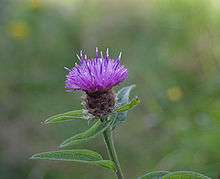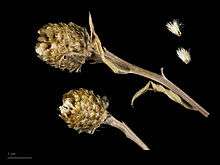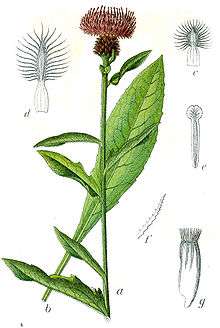Centaurea nigra
| Centaurea nigra | |
|---|---|
 | |
| Scientific classification | |
| Kingdom: | Plantae |
| (unranked): | Angiosperms |
| (unranked): | Eudicots |
| (unranked): | Asterids |
| Order: | Asterales |
| Family: | Asteraceae |
| Tribe: | Cynareae |
| Genus: | Centaurea |
| Species: | C. nigra |
| Binomial name | |
| Centaurea nigra L. | |


Centaurea nigra is a species of flowering plant in the daisy family known by the common names Lesser Knapweed, Common Knapweed and Black Knapweed. A local vernacular name is Hardheads.
It is native to Europe but it is known on other continents as an introduced species and often a noxious weed.
Description
It is a perennial herb growing up to about a metre in height.
The leaves are up to 25 centimetres long, usually deeply lobed, and hairy. The lower leaves are stalked, whilst the upper ones are stalkless.
The inflorescence contains a few flower heads, each a hemisphere of black or brown bristly phyllaries. The head bears many small bright purple flowers. The fruit is a tan, hairy achene 2 or 3 millimetres long, sometimes with a tiny, dark pappus. Flowers July until September.[1] flowers sometimes are yellow, or white
Wildlife value
Important for Gatekeeper butterfly, Goldfinch, Honey bee, Large skipper, Lime-speck pug moth, Meadow Brown, Painted lady, Peacock, Red admiral, Small copper, Small skipper
Similar species
Brown Knapweed Centaurea jacea is different in having pale brown bract appendages, no pappus. Flowers August until September.
References
- ↑ Rose, Francis (1981). The Wild Flower Key. Frederick Warne & Co. pp. 386–387. ISBN 0-7232-2419-6.
External links
| Wikimedia Commons has media related to Centaurea nigra. |
| Wikispecies has information related to: Centaurea nigra |